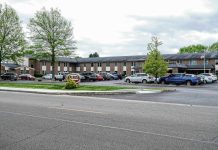Cummins revealed the five historic Indy 500 race cars that will be driven by veteran Speedway drivers in pre-race parade laps on Sunday in honor of the diesel engine-maker’s 100th anniversary.
The announcement was made Wednesday morning at the Indianapolis Motor Speedway Museum, where the five fully-restored historic Cummins-powered cars were in the same location for the first time in history.
To commemorate Cummins’ 100th anniversary, the cars will be in a vintage parade lap just prior to the green flag dropping for the 103rd Indianapolis 500, Cummins officials said.
Veteran drivers assigned to drive the cars include Columbus’ own Tony Stewart, two-time Brickyard 400 winner at the Speedway and Johnny Rutherford, who will have rival and fellow legendary driver Al Unser Sr. as his passenger in one of the two-seater cars.
The five cars in the vintage parade lap include:
- 1931 Cummins Diesel No. 8 car: The 1931 car featured a 4-cylinder diesel engine and was the first ever race car to finish the 500-mile race without stopping. The car qualified in the 17th position at 96.87 miles per hour. The car, originally driven by Dave Evans, finished the race in 13th place.
- 1934 Cummins Diesel No. 5 car: The 1934 No. 5 car featured a new technology, a two-stroke Model H supercharged diesel engine. The car qualified in the 29th position, completed all 500 miles and finished in 12th place. Although the No. 5 completed the race, Cummins founder Clessie Cummins decided not to continue manufacturing the two-stroke Model H, as it was not dependable (the engine seized at the end of the race and would not restart). This care was originally driven by Stubby Stubblefield.
- 1934 Cummins Diesel No. 6 car: The 1934 No. 6 car, originally driven by Dave Evans, was powered by a four-stroke Model H engine. The car qualified in the 22nd position with a speed of 102.2 miles per hour and was only a couple of seconds off the pace of the leaders, however, the car only finished 270 miles and finished 19th.
- 1950 Cummins Diesel Special (Green Hornet) No. 61 car: To promote the release of a new technology, a six-cylinder, two valve truck engine (JBS-600), the 1950 No. 61 car was powered by a modified version of the new engine and was the first racing car in history to use disc brakes. The car, originally driven by Jimmy Jackson, was dubbed the Green Hornet and qualified in the 32nd position, with a speed of 129.9 miles per hour, and finished the race in 29th.
- 1952 Cummins Diesel Special No. 28 car: The 1952 Cummins Diesel Special No. 28, originally driven by Freddy Agabashian, proved the durability, power and technology of diesel engines. The No. 28 was the first turbocharged car to race at the Indy 500, and won the pole position with an average speed of 138 miles per hour and a top speed of 139.1 miles per hour. The No. 28 finished 27th due to debris on the track, however, its dominance prompted new rules for diesel engines competing in the Indy 500. This was the last Indianapolis 500 where Cummins competed with an engine of its own.
For more on this story, including a full list of drivers and photos, see Thursday’s Republic.




